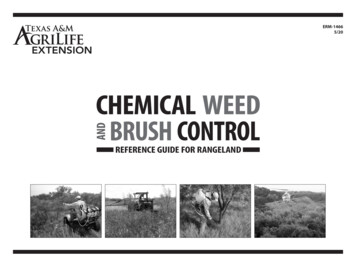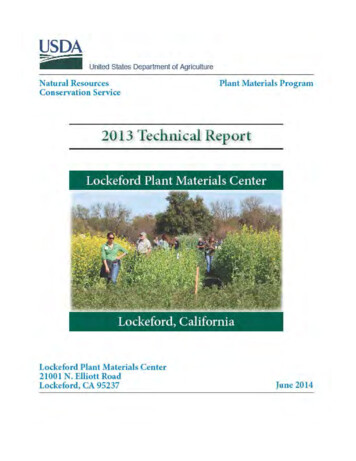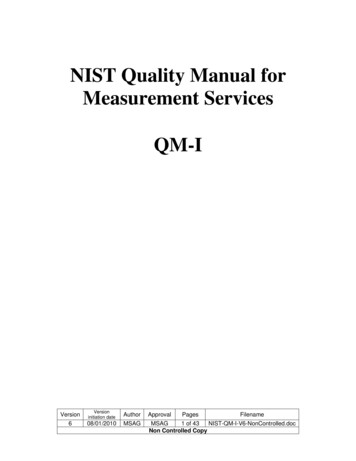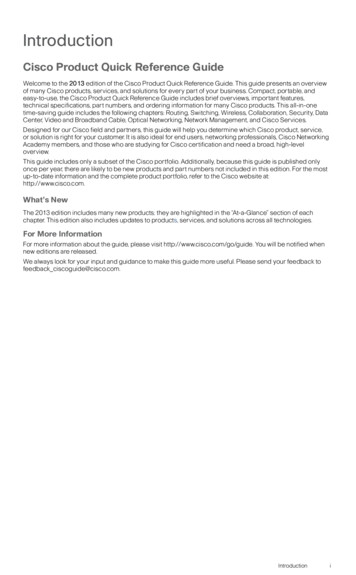
Transcription
ERM-14665/20REFERENCE GUIDE FOR RANGELAND
Chemical Weed and Brush ControlReference Guide for RangelandRobert K. Lyons, Megan Clayton, Larry Redmon, Barron Rector, Steven Evans, and Charles Kneuper*This publication provides general suggestions for herbicides used to control brush and weeds on Texas rangelands. It alsogives information on the levels of control expected. The information is presented in good faith, but no warranty, expressor implied, is given. Weed and brush control results may vary tremendously if treatments are applied under less thanoptimum conditions.Users of this publication may find the decision support system for rangeland weed and brush control technologyselection—PestMan—helpful. PestMan is designed to recommend appropriate mechanical and chemical rangeland brushand weed control treatments for Texas and New Mexico. All herbicide treatments included in this publication are alsoincluded in PestMan, which helps in estimating costs and the economic impact of various treatment options.How to use this guide1. Find your problem weed or brush species in theIndex on page 3.2. Click on or touch the page number thatcorresponds to the plant to go to the page where itis listed; find the plant name in the first column onthose pages.3. See the second column on those pages for a list ofsuggested herbicides (these are active ingredients).4. Choose herbicides based on:a. Whether you would like to make a broadcastapplication or treat individual plants (third orfourth column).b. Check the effectiveness (VH, H, M, and L),which tells you the percentage of plants youshould expect to kill with that herbicide andrate. For percent kill ranges, see page 4.c. See the fifth column for the method to use—how to apply the chemical. This could be foliar,stem, cut-stump, aerial, etc.5. The three columns on the right explain otherdetails such as how much surfactant to use, when totreat the plant, and any exceptions. Be sure to readthese before choosing an herbicide.6. Go to page 5 and match the herbicide you chose forcontrolling the problem plant with product namesyou are more likely to know.7. For tips on measuring and mixing herbicides, seepage 6.*Professor and Extension Range Specialist, Associate Professor and Extension Range Specialist, Professor and Extension Forage Specialist, Associate Professor and Extension Range Specialist,Lecturer, The Texas A&M University System; and State Rangeland Management Specialist, USDA–Natural Resources Conservation Service2
IndexControl descriptions for weed and brush plants are located on the page numbers indicated. Carefully check the table. More than one control measure may exist.Weed speciesPageAfrican rue.7Berlander lobelia.7, 8Bitter sneezeweed .7, 8Broomweed (annual or common). 8, 9Broom snakeweed. 9, 10Buffalobur.7, 8Bullnettle. 10, 11Camphorweed.7, 8Carolina horsenettle.10Cocklebur.7, 8Common goldenweed.11Croton.7, 8Dogfennel.10Drummond’s goldenweed.11Flathead sedge.12Gray goldaster.13Horehound.7, 8Jimmyweed.14Lespedeza.13Marshelder . 7, 8Narrowleaf goldaster.13Perennial broomweed. 9, 10Plantain. 8, 9Prairie gerardia.7, 8Ragweed.7, 8Rayless goldenrod.14Rosin weed.10Silverleaf nightshade. 10, 11Smartweed.7, 8Spiny aster.14Sunflower.7, 8Tallowweed. 8, 9Thistles.7, 8Threadleaf groundsel.12, 14Treadsalve. 10, 11Twinleaf (twoleaf) senna.15Upright prairie-coneflower.10, 15Western bitterweed.7, 8Western horsenettle. 10, 11Western ragweed.7, 8Wild carrot. 8, 9Wolfweed.14Woolly locoweed.12Yankeeweed.10Brush speciesPageAgarito.16Ashe juniper.16Baccharis.16, 17Beebrush.18, 35Beebush.18, 35Bigelow shinoak.17Blackberry.17Blackbrush.17, 18, 30, 31Blackgum.18Blackjack oak.18Blueberry cedar.16Bois d’arc. 17, 18Bumelia.16Burrobrush.18Catclaw acacia.16, 17, 30, 31Catclaw mimosa.16, 17, 18, 31Cenizo.19Chinese tallowtree.17, 19Cholla.16Christ thorn .19, 26Common persimmon. 20Coyotillo.16Creosotebush. 20Dog cactus.16Dryland willow.16, 17Eastern persimmon. 20Eastern redcedar. 20Elm.17, 18, 20Flameleaf sumac.16, 20, 21Giant reed.21Granjeno.20, 30, 31Greenbriar. 17, 21Guajillo.18, 30, 31Hackberry.17, 18, 20Hardwoods. 18, 21, 26Hercules club.17, 18, 20Honeylocust. 22Huisache.20, 21, 22, 23, 25, 30, 31Lotebush. 16, 18, 20, 24Macartney rose. 24Mesquite.25, 26, 27, 28, 29, 30, 31Mesquite, western honey. 30Mixed brush–South Texas.30, 31Mixed brush–Davis Mountains.31Mohrs shinoak.31Post oak.18Pricklyash (Hercules club).17, 18, 20Pricklypear. 30, 31, 32Redberry cedar.16, 32, 33Redberry juniper.16, 32, 33Retama. 30, 31, 33Roosevelt willow.16, 17Running live oak. 34Sacahuista. 34Saltcedar. 34Sand sagebrush. 34Sand shinnery oak. 35Saw palmetto. 35Seep willow.16, 17Skunkbush.30, 31Spiny hackberry.20, 30, 31Sweetgum.18Tarbush. 20Tasajillo. 16, 30, 31, 32Texas mountain laurel.16Texas persimmon. 17, 35Twisted acacia.25, 30, 31White shinoak.17Whitebrush. 16, 18, 31, 35Whitethorn acacia. 20Willow.18Willow baccharis.16, 17Winged elm. 17, 18Yaupon. 17, 20, 36Yucca. 363
Millions of acres of Texas rangeland support an excessive cover of woodyplants and forbs. Dense stands of brush and weeds use valuable waterfor growth, reduce grass production, and cause soil erosion. Herbicidesare an efficient and effective way to manage these noxious plants, control brushand weeds, improve the condition of rangeland, and maintain its productivity.This publication lists current suggestions for herbicide use to control brush andweeds on rangeland. Some herbicides provide a high degree of control of certainspecies; however, seldom is a species eradicated. Consider other potential rangeland uses when developing a brush management program. Many trees, shrubs,and forbs are valuable as food and cover for wildlife and may be an importantcomponent in livestock diets. Therefore, a brush management program shouldprovide for control methods that give optimum benefits to livestock and wildlife.Herbicide application may increase the palatability of poisonous plants. Thus,they are more likely to be consumed by livestock. To prevent losses to toxicplants, do not graze herbicide-treated areas with poisonous plants present untilthe toxic plants dry up and lose their palatability.Properly used herbicides are effective and safe. Misuse can result in poor brushand weed control, herbicidal drift, dangerous residues, or death of desirableplants. Listed below are points to follow for proper herbicide use: Identify the weed or brush species and evaluate the need for control. Consider the expected benefits, costs, and alternative control practices. Buy the suggested herbicide for the weed or brush species. Read and follow herbicide label directions for allowable uses, application rates,and special handling or mixing requirements. Provide and require the use of proper safety equipment. Calibrate spray equipment. Mix herbicides in a ventilated area, preferably outside. Spray under conditions that prevent drift to susceptible crops. Apply the herbicides at the suggested rate and time. Keep a record of the herbicide used, the time required to spray, weather conditions, rate of herbicide in the carrier, date, location, and the person using theherbicide.Suggestions on the use of herbicides made by the Texas A&M AgriLife ExtensionService are based upon effectiveness under Texas conditions.Broadcast and individual plant treatments are presented in Tables 6 and 7. Individual plant treatments are suited for controlling thin stands of brush and selective control. Broadcast treatments are useful for dense stands of brush and forweed control.Suggested herbicides must be registered with and the labels approved by theEnvironmental Protection Agency. Because the status of herbicide label clearance is subject to change, be certain that the herbicide is currently labeled for theintended use.The users are always responsible for the effects of herbicide residue on their livestock and crops, as well as for problems that could arise from drift or movementof the herbicide from their property to that of others. Always read and carefullyfollow the instructions on the container label.Treatment control ratingsA control rating, based on the effectiveness of an herbicide treatment in controlling a target plant, has been assigned to each herbicide use suggestion. Theseratings were determined from research and result demonstration data and fromobservations of commercial applications. The rating represents a degree of plantmortality of the target plant species when the treatment is applied properlyunder optimum conditions.Table 1. Rating categories for herbicide treatmentsand degree of target plant mortality after treatmentControl ratingPercent of plants killedVery high76–100High56–75Moderate36–55Low0–35The sprayer used must apply the correct quantity of herbicide mixture to a specific area. To calibrate spray equipment, see Extension publication EL-5465,Weed Busters: Sprayer Calibration Guide.4
Table 2. Common, chemical, and product names of herbicides*Herbicide common nameChemical nameProduct nameActive ingredientor acid equivalentaminocyclopryachlor:triclopyr inecarboxylic acid, potassium saltSee triclopyr amineInvora2 lb/galaminopyralid2-pyridine carboxylic acid, 4-amino-3, 6-dichloro-2-pyrdine carboxylic acid,triisopropanolammonium salt——aminopyralid:2,4-D (1:8)See aminopyralid and 2,4-DGrazonNext HL3.75 lb/galaminopyralid:clopyralid (1:4.6)See aminopyralid and clopyralidSendero2.8 lb/galaminopyralid:metsulfuron methyl (1:6.2)See aminopyralid and metsulfuronChaparral0.62 lb/galaminopryralid:picloram:fluroxypyr (1:2:2)See aminopyralid, picloram, and fluroxypyrMezaVue2 lb/galclopyralid3,6-dichloro-2-pyridinecarboxylic acidPyramid R&P, Sonora3 lb/gal2,4-D(2,4-dichlorophenoxy) acetic acidWeedar 64, Broad Range 55, Hi-Dep,Weedone LV4, Esteron 99, Unison, othersamine salts, free acids, and estersof variable concentrationdicamba3,6-dichloro-2-methoxybenzoic acidBanvel, Clarity, Vision4 lb/galdicamba:2,4-D (1:3)See dicamba and 2,4-DWeedmaster, Banvel 2,4-D, RangeStar,Outlaw4 lb/galdicamba:2,4-D (1:1.3)See dicamba and 2,4-DLatigo4 lb/galdiesel fuel oil or kerosenerefined petroleum fractionsSeveral manufacturers—fluroxypyr1-methylheptyl ester: etic acidVista XRT2.8 lb/galglyphosateN-(phosphonomethyl) glycineSeveral, including Rodeo**, Roundup,Roundup Ultradry, Glyphosate 417isopropylamine salt; concentrationvaries depending on the methyl-1,3,5-triazine-2,4(IH, 3H)-dioneVelpar L, Pronone Power Pellet2 lb/gal (Velpar L)75% (Pronone Power ethy)-5-oxo-lH-imidazol-2-yl]-3-pyridinecarboxylic acidArsenal, Habitat**2 lb/galmetsulfuron methylmethyl bonyl]amino] sulfonyl] benzoateEscort, Clean Pasture, MSM 60DF60%metsulfuron:chlorosulfuron (3:1)See metsulfuron methyl )aminocarbonyl]benzenesulfonamideCimarron Plus48% metsulfuron15% chlorosulfuronmetsulfuron:chlorosulfuron (1:1)See metsulfuron: chlorosulfuronCimarron X-Tra30% metsulfuron37.5% chlorosulfuronmetsulfuron methyldicamba:2,4-D (1:3)See metsulfuron methyl, dicamba, and 2,4-DCimarron Max60% (Part A)3.87 lb/gal (Part ylic acidTordon 22K, Triumph 22K, Picloram 22K2 lb/galpicloram:fluroxypyr (1:1)See picloram and fluroxypyrSurmount1.34 lb/galpicloram:2,4-D (1:4)See picloram and 2,4-DGrazon P D, Gunslinger, Picloram D2.5 lb/galpicloram:2,4-D (1:4)See picloram and 2,4-DGraslan L3.8 adiazol-2-yl}-N-N’-dimethylureaSpike 20P, Spike 80 DF20% (Spike 20P)80% (Spike 80 DF)triclopyr amine3,5,6-trichloro-2-pyridinyloxyacetic acid, triethylamine saltGarlon 3A3 lb/galtriclopyr ester3,5,6-trichloro-2-pyridinyloxyacetic acid, butoxyethyl esterClear Pasture, Pathfinder II, Triclopyr R&P,Remedy Ultra, Triclopyr 4 EC0.75 lb/gal (Pathfinder II–ready-to-useformulation for stem sprays)4 lb/gal (all others)triclopyr:fluroxypr (3:1)See triclopyr and fluroxypyrPastureGard HL4 lb/galtriclopyr:2,4-D (1:2)See triclopyr and 2,4-DCrossbow3 lb/gal*Herbicides have been identified by the accepted Weed Science Society of America common name, and when practical, one or more product names.**Aquatic label5
Table 3. Common measurement conversions for use with herbicide applicationsLiquidWeight1 gallon (gal) 4 quarts (qt)1 gal 8 pints (pt)1 gal 16 cups (c)1 gal 128 ounces (oz)1 gal 3784.96 milliliters (ml)1 quart (qt) 2 pt1 qt 4 c1 qt 32 oz1 qt 946.24 ml1 pint (pt) 2 c1 pt 16 oz1 pt 473.12 ml1 c 8 oz1 oz 2 tablespoons (tbs)1 oz 29.57 ml1 tablespoon (tbs) 3 teaspoons (tsp)1 tbs 0.5 oz1 tbs 14.79 ml1 teaspoon (tsp) 4.98 ml1 pound (lb) 16 oz1 lb 453.6 grams (g)1 oz 28.35 g1 kilogram (kg) 2.2 lbArea1 acre 43,560 square feet (sq ft)1 hectare (ha) 2.471 acresTable 4. Guide to quantity of herbicide formulation for total volume of spray mixHerbicide concentration desired for individual plant and spot treatmentTotal sprayvolume desired0.25 %0.5 %0.75 %1%*1.5%2%3%4%5%10%15%25%Quantity of herbicide formulation1 gal0.32 oz0.64 oz1 oz1.28 oz2 oz2.56 oz4 oz5.12 oz6.4 oz12.8 oz19 oz1 qt3 gal*1 oz2 oz3 oz4 oz*6 oz8 oz12 oz15.5 oz19 oz38 oz57 oz96 oz5 gal1.67 oz3.33 oz5 oz6.5 oz10 oz13 oz19 oz26 oz32 oz64 oz96 oz1.25 gal10 gal3.33 oz6.5 oz10 oz13 oz19 oz26 oz38 oz51 oz2 qt1 gal1.5 gal2.5 gal25 gal8 oz16 oz24 oz32 oz48 oz64 oz96 oz1 gal1.25 gal2.5 gal3.75 gal6.25 gal50 gal16 oz32 oz48 oz64 oz96 oz1 gal1.5 gal2 gal2.5 gal5 gal7.5 gal12.5 gal100 gal32 oz64 oz96 oz1 gal1.5 gal2 gal3 gal4 gal5 gal10 gal15 gal25 gal*Example: To prepare 3 gal of a spray mixture (herbicide, water, and surfactant) containing 1% herbicide, add 4 oz of herbicide.Note:Add 0.25%–0.5% commercial, non-ionic surfactant or crop oil, or methylated seed oil according to product label for mixtures using only water as the herbicide carrier.6
Back to IndexTable 5. Herbicides for controlling weeds on rangelandWeed controlledAfrican rueBerlander lobelia, bittersneezeweed, buffalobur,camphorweed, cocklebur,croton, horehound,marshelder (sumpweed,sulfaweed), prairie gerardia(see remarks), ragweed,smartweed, sunflower,thistles, western bitterweed(see remarks), westernragweed, others(continued on next page)Herbicide (common andchemical names, Table 2)Herbicide quantity(active ingredient rate in parenthesis)Spray volume(per acre for broadcast, asdescribed for individual plant)Broadcast rateper acreIndividual plant/spot treatment*hexazinone liquid—VH**2 ml/plantUse an exact delivery handgun toapply undiluted herbicide to soilsurface at the edge of the plantcanopy.hexazinone pellet—1 pellet/plant—tebuthiuron 20% pelletsH7.5 lb (1.5 lb)——imazapyrH32 oz (0.5 lb)VH0.5%2,4-D amine or low volatileesterVH**16–32 oz (0.5–1 lb)4 lb/gal productVH1% (4 lb/gal product)dicamba:2,4-D (1:3)VH16–32 oz (0.5–1 lb)VH1%dicamba:2,4-D (1:1.3) 2,4-D amine or low volatileesterVH9–22 oz (0.28–0.69 lb)dicamba:2,4-D (1:1.3) 14–32 oz (0.44–1 lb)2, 4-D (4 lb/gal product)—dicamba 2,4-D amineor low volatile esterVH4–8 oz (0.125–0.75 lb)dicamba 12–24 oz (0.375–0.75 lb)2, 4-D (4 lb/gal product)VH0.25% dicamba 0.75 %2,4-D (4 lb/gal product)picloram:2,4-D (1:4),(3.8 lb/gal product)VH11–16 oz (0.3–0.5 lb)VH0.63%picloram:2,4-D (1:4),(2.5 lb/gal product)VH16–24 oz (0.3–0.5 lb)VH1%picloram 2,4-D amineor low volatile esterVH8–24 oz (0.0625–0.1875 lb)picloram 8–24 oz (0.25–0.75 lb)2,4-D (4 lb/gal product)VH0.25% picloram 0.5%2,4-D (4 lb/gal product)Timeto applySpring–summerRemarksDo not use on heavy clay or caliche soils.10–25 gal/ac for groundLate Sept–Octbroadcast. Thoroughly wet foliage (to first frost)for individual plant treatment. Add32–64 oz surfactant/100 gal water.Apply to fall regrowth that is in goodgrowing condition. Recommend usingindividual plant treatment when growingwith desirable vegetation to reduce nontarget damage. Imazapyr is a non-selectiveherbicide and will kill or damage desirablevegetation if sprayed.2–4 gal water for aerial spray;10–25 gal water for groundbroadcast application. Thoroughlywet foliage for individualplant treatment. Add 32–64 ozsurfactant/100 gal water.With 2,4-D, use the amine formulation inareas with 25 in. of rainfall or more and theester formulation in drier areas where nosusceptible crops are nearby.Spring, weeds 4–6 in.high, good moistureconditions. Spraythistles in rosettestage.For western bitterweed control, use2,4-D low volatile ester or amine at 32oz/ac before plants flower, temperatureabove 72 F, and soil moisture favors plantgrowth. When ¾ of plants are blooming,and/or temperature is less than 60 F, usedicamba:2,4-D (1:3), 2,4-D plus dicamba;picloram:2,4-D (1:4), (3.8 lb/gal product),picloram:2,4-D (1:4), (2.5 lb/gal product),aminopyralid:2,4-D (1:8) or 2,4-D pluspicloram.For prairie gerardia control, use48 oz/acre of 2,4-D or the low rate ofdicamba:2,4-D (1:3), dicamba plus 2,4-D;picloram:2,4-D (1:4), (3.8 lb/gal product),picloram:2,4-D (1:4), (2.5 lb/ gal product) orpicloram plus 2,4-D when plants are 4–6in. high. Use 20 oz/acre of picloram:2,4-D(1:4), (3.8 lb/gal product; Do not apply morethan 80 oz/acre per year), 32 oz/acre ofpicloram:2,4-D (1:4), (2.5 lb/ gal product) or8 oz of 2,4-D/acre when plants are 6–10 in.high before flowering.*See Table 4 for mixing information.**Treatment control ratings: VH – Very High; H – High; M – Moderate; L – LowTable 5. Herbicides for controlling weeds on rangeland7
Back to IndexWeed controlledHerbicide (common andchemical names, Table 2)Herbicide quantity(active ingredient rate in parenthesis)Broadcast rateper acreIndividual plant/spot treatment*VHRate 1–Rate 2—picloram:fluroxypyr (1:1)VH24–32 oz (0.25–0.33 lb)VH1%Spray volume(per acre for broadcast, asdescribed for individual plant)metsulfuron methyldicamba:2,4-D (1:3)triclopyr:fluroxypr (3:1)H16–24 oz (0.5–0.75 lb)VH0.5%Use high end of rate range forcamphorweed, marshelder, and smartweed.Triclopyr:fluroxypr (3:1) efficacy onsmartweed is marginal.(continued from previouspage)aminopyralid:2,4-D (1:8)VH24 oz (0.70 lb)——aminopyralid:metsulfuronmethyl (1:6.2)VH2.0–3.3 oz (0.078–0.127 lb)—Broomweed (annualor common), plantain(tallowweed), wild carrot2,4-D amine or low volatileesterVH**16–32 oz (0.5–1 lb)4 lb/gal productVH1% (4 lb/gal product)(continued on next page)aminopyralid:2,4-D (1:8)VH24 oz (0.70 lb)—VH2.0-3.3 oz (0.078–0.127 lb)—VH16–32 oz (0.5–1 lb)VH1%dicamba:2,4-D (1:1.3) 2,4-D amine or low volatileesterVH9–22 oz (0.28–0.69 lb)dicamba:2,4-D (1:1.3) 14–32 oz (0.44–1 lb)2, 4-D (4 lb/gal product)—dicamba 2,4-D amineor low volatile esterVH4–8 oz (0.125–0.25 lb)dicamba 12–24 oz (0.375–0.75 lb)2,4-D (4 lb/gal product)VH0.25% dicamba 0.75%2,4-D (4 lb/gal product)picloram:2,4-D (1:4),(3.8 lb/gal product)VH11–16 oz (0.3–0.5 lb)VH0.63%picloram:2,4-D (1:4),(2.5 lb/gal product)VH16–24 oz (0.3–0.5 lb)VH1%dicamba:2,4-D (1:3)Spring, weeds 4–6 in.high, good moistureconditions. Spraythistles in rosettestage.RemarksBerlander lobelia, bittersneezeweed, buffalobur,camphorweed, cocklebur,croton, horehound,marshelder (sumpweed,sulfaweed), prairie gerardia(see remarks), ragweed,smartweed, sunflower,thistles, western bitterweed(see remarks), westernragweed, othersaminopyralid:metsulfuronmethyl (1:6.2)2–4 gal water for aerial spray;10–25 gal water for groundbroadcast application. Thoroughlywet foliage for individualplant treatment. Add 32–64 ozsurfactant/100 gal water.Timeto applyBecause of metsulfuron methyl in theformulation, these herbicides are notrecommended on bahiagrass pastures forweed control.Use high end of rate range for camphorweed, marshelder, and smartweed.Because of metsulfuron methyl in theformulation, these herbicides are notrecommended on bahiagrass pastures forweed control.2–4 gal water for aerial spray;10–25 gal water for groundbroadcast application. Thoroughlywet foliage for individualplant treatment. Add 32–64 ozsurfactant/100 gal water.Spring, weeds lessthan 4 in. tall, goodmoisture conditions.Use 2,4-D amine in areas with 25 in. ofrainfall or more. Use 2,4-D low volatile esterin drier areas where no susceptible cropsare nearby.Picloram:2,4-D (1:4), (3.8 lb/gal product): Donot apply more than 80 oz/acre per year.*See Table 4 for mixing information.**Treatment control ratings: VH – Very High; H – High; M – Moderate; L – LowTable 5. Herbicides for controlling weeds on rangeland8
Back to IndexWeed controlledBroomweed (annualor common), plantain(tallowweed), wild carrot(continued from previouspage)Herbicide (common andchemical names, Table 2)Herbicide quantity(active ingredient rate in parenthesis)Broadcast rateper acreIndividual plant/spot treatment*VH8–24 oz (0.0625–0.1875 lb)picloram 8–24 oz (0.25–0.75 lb)2,4-D (4 lb/gal product)VH0.25% picloram 0.5%2,4-D (4 lb/gal product)picloram:fluroxypyr (1:1)VH24–32 oz (0.25–0.33 lb)VH1%triclopyr:fluroxypr (3:1)H16–24 oz (0.5–0.75 lb)VH0.5%metsulfuron methyldicamba:2,4-D (1:3)VHRate 1–Rate 2—metsulfuron methylVH0.1 oz—metsulfuron:chlorosulfuron (3:1)VH0.125 oz—metsulfuron:chlorosulfuron (1:1)VH0.2 oz—VH16–32 oz (0.25–0.5 lb)VH0.5%picloram 2,4-D amineor low volatile esterBroom snakeweed(perennial broomweed)picloram(continued on next page)picloram:2,4-D (1:4),(3.8 lb/gal product)VH43 oz (1.25 lb)VH0.63%picloram:2,4-D (1:4),(2.5 lb/gal product)VH64 oz (1.25 lb)VH1%VH48–96 oz (0.5–1.0 lb)VH1%picloram 2,4-D amineor low volatile esterVH16 oz (0.25 lb) picloram 16–32 oz (0.5–1 lb)2,4-D (4 lb/gal product)VH0.25% picloram 0.5%2,4-D (4 lb/gal product)dicamba:2,4-D (1:3)VH32 oz (1 lb)VH1%dicamba:2,4-D (1:1.3) 2,4-D amine or low volatileesterVH9–22
All herbicide treatments included in this publication are also . Because the status of herbicide label clear-ance is subject to change, be certain that the herbicide is currently labeled for the . Weedar 64, Broad Range 55, Hi-Dep, Weedone LV4, Esteron 99, Unison, others amine










